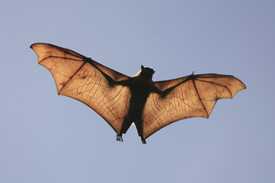Bats

Rabid bats have been documented in all 49 continental states. Hawaii is rabies-free. Bats are increasingly implicated as important wildlife reservoirs for variants of rabies virus transmitted to humans.
Recent data suggest that transmission of rabies virus can occur from minor, seemingly unimportant, or unrecognized bites from bats. Human and domestic animal contact with bats should be minimized, and bats should never be handled by untrained and unvaccinated persons or be kept as pets.
In all instances of potential human exposures involving bats, the bat in question should be safely collected, if possible, and submitted for rabies diagnosis. Rabies postexposure prophylaxis is recommended for all persons with bite, scratch, or mucous membrane exposure to a bat, unless the bat is available for testing and is negative for evidence of rabies.
Postexposure prophylaxis should be considered when direct contact between a human and a bat has occurred, unless the exposed person can be certain a bite, scratch, or mucous membrane exposure did not occur.
In instances in which a bat is found indoors and there is no history of bat-human contact, the likely effectiveness of postexposure prophylaxis must be balanced against the low risk such exposures appear to present. Postexposure prophylaxis can be considered for persons who were in the same room as a bat and who might be unaware that a bite or direct contact had occurred (e.g., a sleeping person awakens to find a bat in the room or an adult witnesses a bat in the room with a previously unattended child, mentally disabled person, or intoxicated person) and rabies cannot be ruled out by testing the bat. Postexposure prophylaxis would not be warranted for other household members.
Rabid Bats Reported in the United States
2008 | 2009 | 2010 | 2011 | 2012 | 2013 | 2014 | 2015
For more information about bats, visit the Rabies: Bats site.
- Page last reviewed: July 5, 2017
- Page last updated: July 5, 2017
- Content source:





 ShareCompartir
ShareCompartir